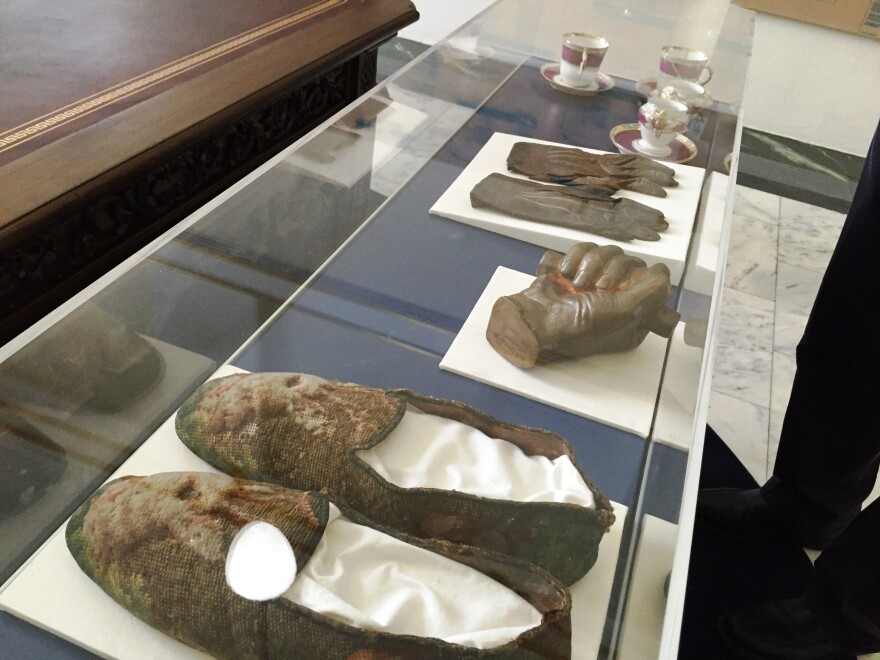
The nation’s oldest presidential library is celebrating its centennial today in a northwest corner of Ohio. WKSU’s M.L. Schultze toured the newly renovated Rutherford B. Hayes presidential center to learn more of the story of one of America’s long-shot presidents – whose first step was at a raucous convention in Ohio.
Rutherford B. Hayes was a popular Ohio governor who – according to one of the more caustic of the observers of the 1876 presidential race was "a third-rate non-entity, who’s obnoxious to no one.”
Kevin Kern, who literally wrote the textbook on Ohio history and teaches the topic at the University of Akron, says that's unduly harsh
Both he and Christie Weininger, the curator of the Rutherford B. Hayes presidential center in Fremont, Ohio, say there was a lot more to the man. He was a Civil War general wounded five times, a come-from-way-way-behind presidential candidate, and a reformer who helped the GOP overcome the massive corruption of the administration of Ulysses S. Grant.
Artifacts speak to and through Rutherford
And "he was such a pack-rat. And he really understood the power that artifacts have to communicate something to people.”
So Weininger says it was logical for Hayes’ son to build a two-story square stone building with massive columns, a research library and galleries next to the mansion Hayes shared with his beloved wife, Lucy. And to stuff it with some 19,000 artifacts – from bricks from Washington’s birthplace to Lincoln’s now-fuzzy slippers.

“These slippers were actually given to Hayes by the tutor of Lincoln’s boys. So these were the slippers he was wearing in the last year of his life. In fact he had worn them the morning of his assassination…. (fade out)
The presidency that almost wasn't
But before Hayes started collecting things touched by great presidents, mediocre presidents and even bad presidents, he took his own a circuitous route to the White House. He was governor of what was then the third-largest state in the country and had a history of beating well-known Democrats.
Weininger points to a sketch of Exhibition Hall in Cincinnati, laid out on a floor-to-ceiling piece of glass. "This is actually a big image of the Republican convention in Cincinnati, you can see how many people are packed into this hall. There were 4-5000 people there. And you can just imagine, well how hot it must have been for one thing.
Adds Kern, "And if you read the transcript of the convention, they had to keep telling the gallery to shut up."
So Hayes had home-state advantage. But he was still pretty much an afterthought nationally – fifth place with little hope of eclipsing the big political names of the day, especially New York political boss Roscoe Conkling and Maine Sen. James G. Blaine.
Blaine had the delegate edge – but with a scandal brewing. Plus, he and Conkling hated each other, and a lot of the other candidates weren’t fond of either of them. So slowly, the other also-rans peeled off, handing their support to Hayes.

Weininger looks over a chart of round-after-round of delegate votes: "Dramatically, from the sixth to the seventh ballot, that’s where the magic happened."
The Rutherford B. Hayes museum has undergone a $1.5 million renovation that includes a collection of letters from all U.S. Presidents that was started by Hayes.
The fight that wouldn't end
But the seven ballots to win the Republican convention turned out to be the easy part.
Next came the general election battle with Samuel Tilden, a Democrat with reformist credentials of his own.
“Actually Hayes himself thought he was going to lose," Kern notes, and he did – at least the popular vote.
"But then in something that made Bush v. Gore in 2000 looked like child’s play, there is this prolonged crisis over who actually won the election in the Electoral College because there were a series of disputed ballots in places like Dade County, Fla., for instance."

The fight stretched from 1876 into 1877. Less than a week, in fact, before the inauguration, which back in those days was in March, Hayes won by one, much disputed Electoral College vote. And, fearing a Democratic coup, Hayes was secretly sworn in. To one term. By choice.
The Hayes legacy
His presidential reputation remains a mix. Kern and Weininger note that everyone credits him with a clean administration.
Hayes supporters saw him as a uniter who withdrew the last of the federal troops from the South – perhaps more hopeful than convinced that the Southern states would respect the rights of newly freed slaves. For others, the withdrawal ensured Jim Crow laws and other abuses would be dominate the South for a century.

These days, Kern says, a lot of the “beardy guys” who were presidents in the late 1800s seem to blur together.
“But a lot of historians actually give Hayes credit not for any one particular thing he did, but actually bringing the office of the presidency back up to a level of respectability.”







